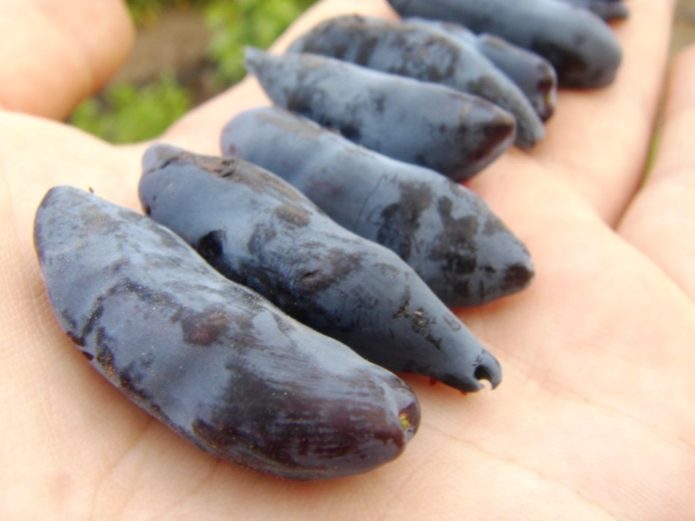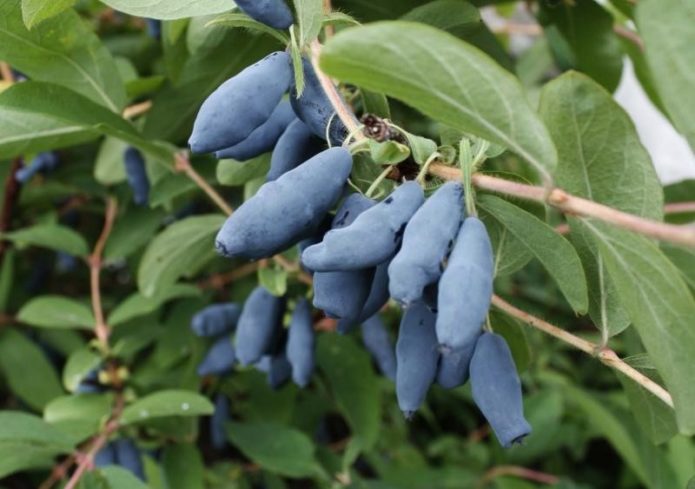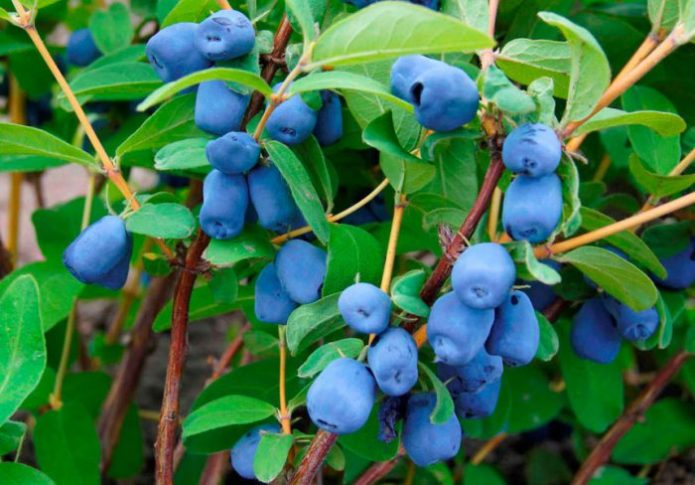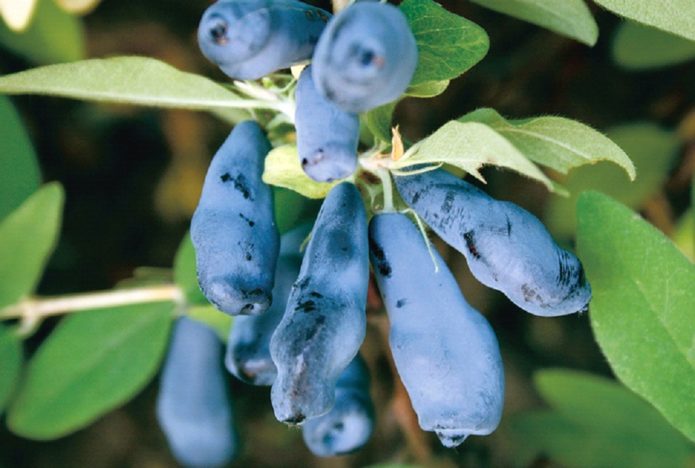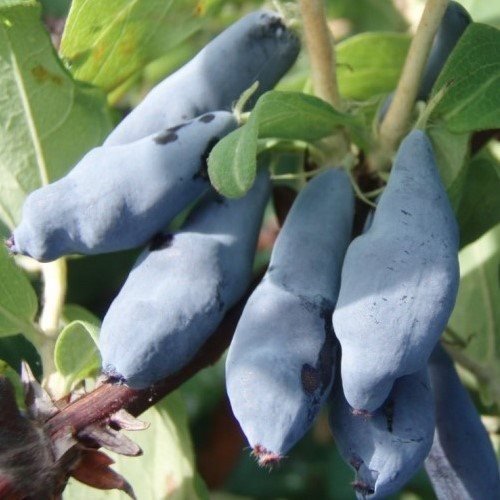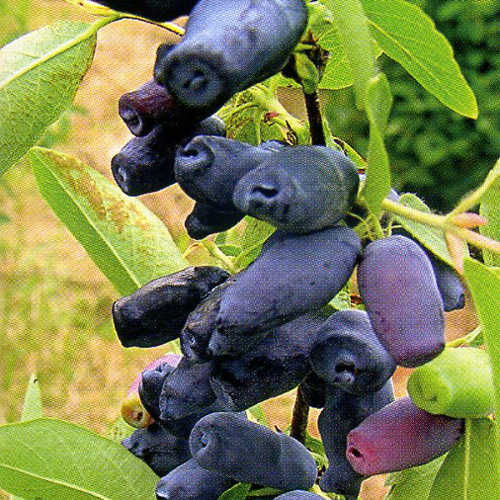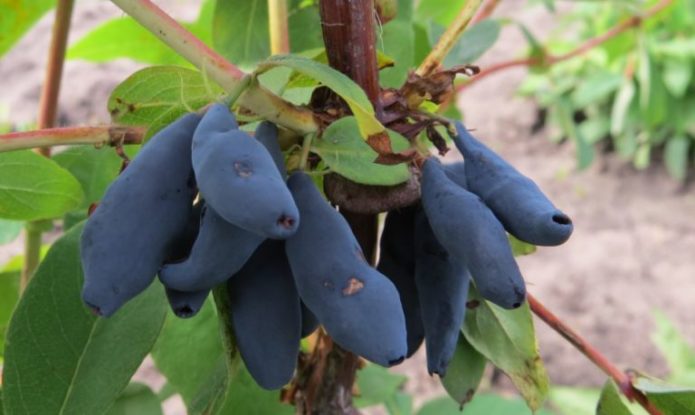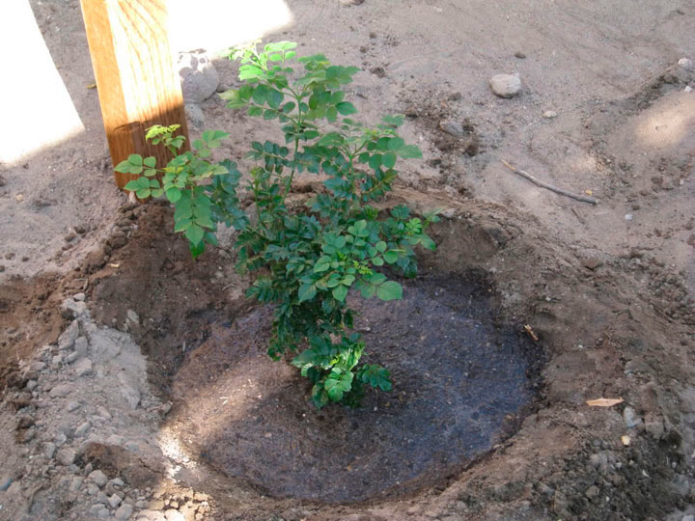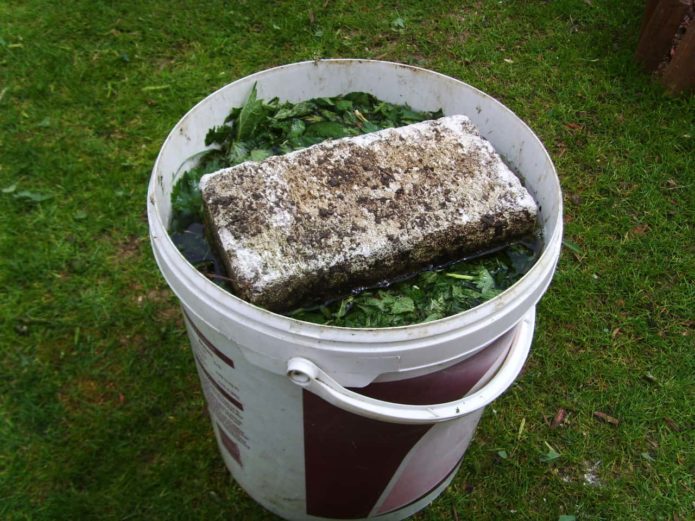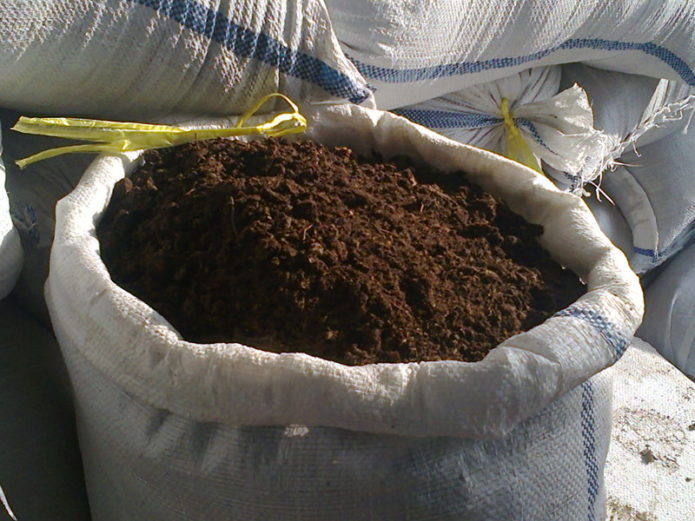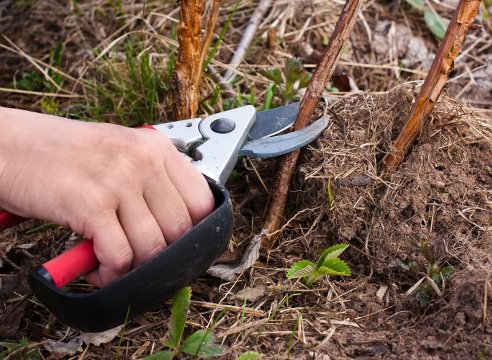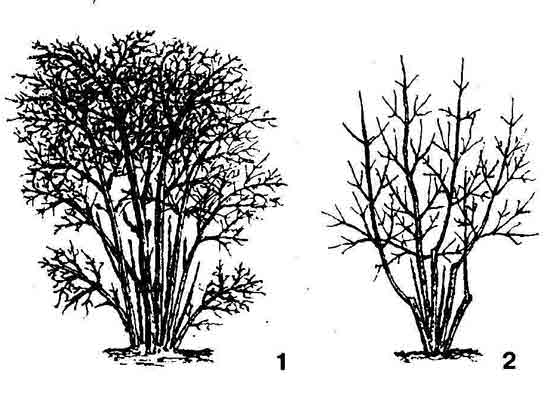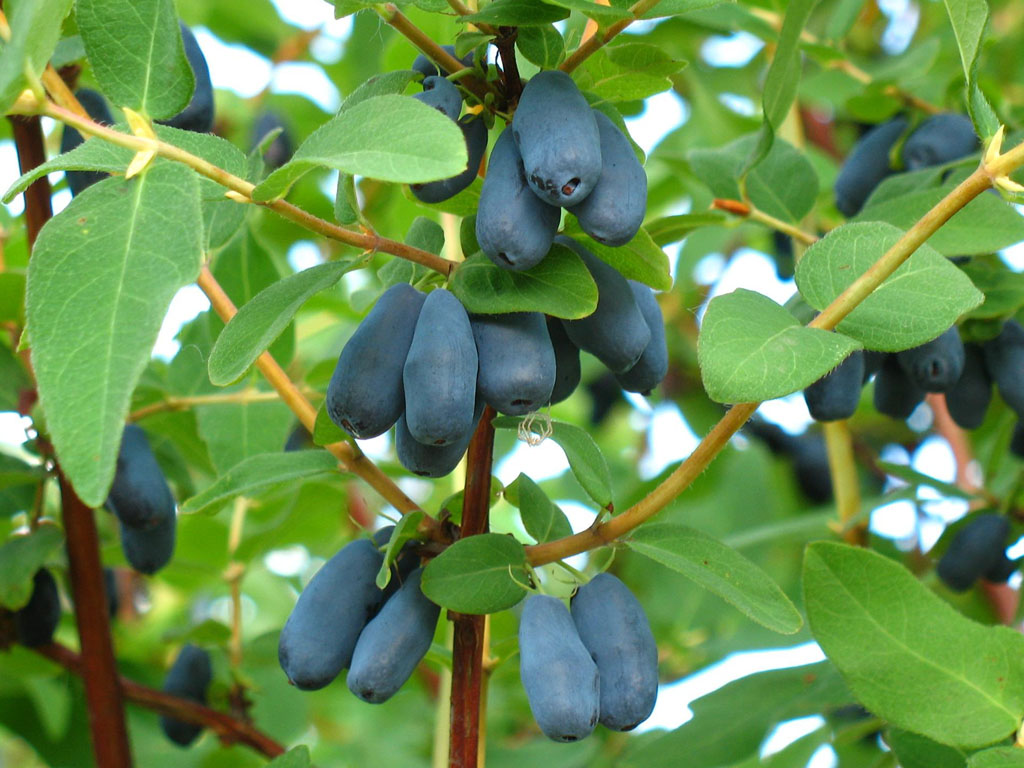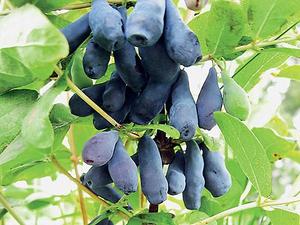Honeysuckle, which has extremely high frost resistance, is traditionally grown in northern regions with a harsh climate. But recently, gardeners living in other areas have begun to pay attention to this tasty and healthy berry. The culture is quite suitable for the Moscow region. In addition to cold resistance, it is valued for its consistently high yield, undemanding care, non-capriciousness regarding growing conditions, and ease of reproduction. Breeders have bred quite a few varieties, having studied their advantages and disadvantages, it is quite possible to choose several of the most suitable ones.
Content
The best varieties of honeysuckle for growing in the Moscow region
When choosing a variety of honeysuckle, you must immediately take into account that the vast majority of its varieties are self-fertile. In order for the fruits to be tied on the bushes, you will need other varieties of culture that bloom at the same time. Usually three plants are planted at once with an interval of no more than 2–3 m between them. You can, of course, rely on the neighbor's honeysuckle, but this does not always give the desired result.
The climate in the Moscow region is such that both early and late-ripening varieties have time to ripen. Therefore, in this matter, you can be guided exclusively by personal preferences.
Altair
The variety has been listed in the State Register of the Russian Federation since 2002, no restrictions on the growing region are indicated. In terms of ripening, it belongs to the mid-season. It has good immunity, relatively rarely suffers from diseases and pests. The variety is used for growing on an industrial scale.
The bush does not differ in growth intensity, the shoots are vertical. Adult specimens reach a height of 1.5 m. The crown spontaneously acquires a fairly regular spherical shape. The help of a gardener is minimal.
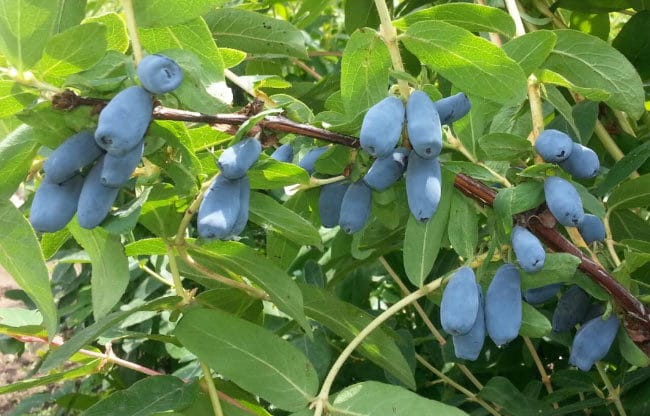
The bushes of Altair honeysuckle are quite compact, the crown does not need frequent and radical pruning
The berries are similar to barrels - fusiform, rather wide. Average weight - 0.92 g. The skin is bluish-blue, covered with a thick layer of bluish bloom. The berries are juicy, soft. The taste is very balanced, sweet, with a slight sourness and characteristic astringency. It is rated quite high by professional tasters - 4.4 points out of five. The content of vitamin C in fruits is 55 mg per 100 g, sugars - 8.3%.
The bush brings its first harvest in the third year after planting. In the future, you can count on 2.5-3 kg from an adult plant. The berries ripen in the last decade of June, do not fall off, even fully ripening. The best pollinators are Blue Spindle, Morena.
Bakchar giant
In the State Register since 2005.On the territory of Russia, it can be grown wherever gardening is generally possible. A variety of medium ripening, extended fruiting. During the entire period of testing and cultivation, no cases of damage by diseases and pests were noted.
The variety is characterized by almost extreme frost resistance. Plants tolerate temperatures down to -50 ° C without much damage to themselves. Buds, flowers and fruit ovaries do not suffer at -10 ° C.
The bush is quite powerful, spreading, fully justifies the name. Its height reaches 2 m, the diameter of the crown is 1.5 m. It is oval, not thickened. Shoots are thick, erect.
The berries are oval, but slightly asymmetrical, elongated (4–5 cm), large (1.8 g). Fruits are dark blue with a gray-gray bloom. The skin is as if bumpy, rather dense. The latter provides good keeping quality and transportability. The taste is refreshing, sweet and sour, very delicate, the bitterness is almost invisible. The variety is considered a dessert, it has earned a close to the maximum mark - 4.8 points. Vitamin C content - 37 mg per 100 g, sugars - 8.4%.
This honeysuckle begins to bear fruit in the third year after planting. 4.5–5 kg of berries are removed from adult plants. The first fruits ripen at the end of June, the rest ripen over the next 2-3 weeks. Collect them regularly, otherwise they will crumble. The best pollinators are Lazurnaya, Nymph, Amphora, and Pride Bakchar varieties.
Video: what does the honeysuckle Bakcharian giant look like?
Blue spindle
Quite an old variety, listed in the State Register in 1989. Belongs to the category of early maturing. Does not suffer from diseases and pests. Fruiting is extended, lasts from mid-June to the second decade of July. Frost resistance up to -34 ° С.
The bush is medium-sized, as if "compressed", rather compact. It very rarely grows above 1.5–2 m, usually stops at 0.8–1 m. Crohn is rare, almost without the help of a gardener takes a rounded shape. Shoots are thin, slightly dull.
Fusiform berries (flat at the base and pointed at the peduncle), deep purple in color, with a bluish bloom. They cannot be called large, the average weight is 0.9 g. From a distance, they seem black. The skin is dense, slightly bumpy. The taste is not bad, but no more - sweet and sour, with a characteristic bitterness. The assessment of professionals is also low - 3.7 points. But preserves, jams and other processed products are quoted very high, by 4.7-5 points. Vitamin C content - 18.5 mg, sugars - 4.9%.
The first harvest is expected for 4–5 years. On average, an adult bush yields about 2 kg of berries. About 10% of the fruits crumble before they ripen. If spring and summer are dry, you can lose more berries. The varieties Blue Bird, Cinderella, Tomichka are suitable as pollinators.
Video: description of the Blue Spindle honeysuckle variety
Cinderella
The variety got into the State Register in 1991. Suitable for growing in all regions. It is early, the fruits ripen in large quantities, in June 15-25. Bushes do not suffer from winter cold and sudden changes in temperature, flowers and buds from recurrent spring frosts. General frost resistance up to -32 ° С.
The bushes are weak, the maximum height is 0.6–0.7 m. Shoots are straight or slightly curved. The leaves are unexpectedly large. Almost all berries are concentrated at the ends of the branches. They are showered very little.
The fruits are rather large (1–1.4 g), elongated. The skin is dark blue, almost black, covered with a thick bluish bloom. It is quite thin, so the berries cannot boast of transportability and keeping quality. The taste is sweet, almost without sourness, very pleasant. His assessment is close to the maximum possible (4.8 points). And processed products are highly rated by professionals.The pulp is very tender, with a light strawberry aroma.
The bush begins to bear fruit in 2-3 years after planting in a permanent place. Average yield, 1.7 kg of berries from an adult plant. Suitable pollinators - Lazurnaya, Kamchadalka, Amphora. The varieties Blue Spindle, Salut, Gerda will not give the desired result in this quality.
Video: an overview of the Cinderella honeysuckle
Leningrad giant
An early variety, which is especially appreciated for sweet fruits without the slightest sourness and bitterness. This quality is actively exploited by breeders. Frost resistance of bushes - up to -40 ° С, flowers - up to -8 ° С. Extended fruiting - from the end of June to the third decade of July.
Bushes for honeysuckle are quite high (1.5–2 m), spherical crown, about 1.6 m in diameter, not too thick. In adult plants, the bark often leaves in whole strips. For them, this is the norm, and not some kind of exotic disease.
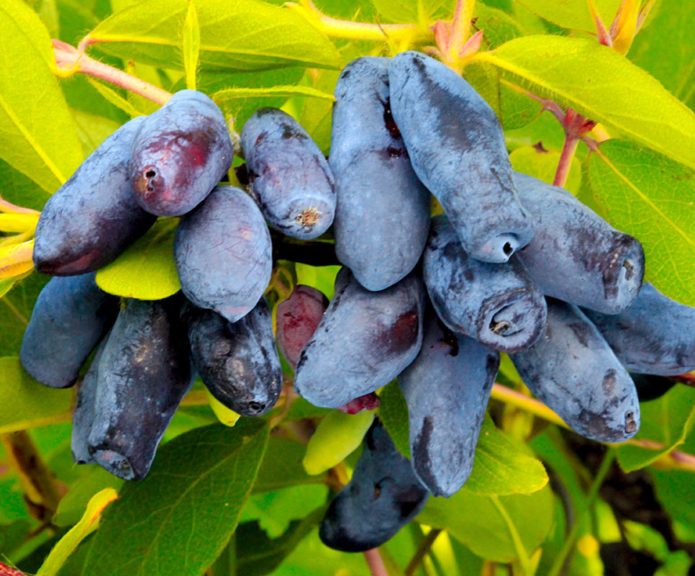
The taste qualities of the Leningrad giant honeysuckle berries are such that breeders are trying to "graft" them into many new varieties
The fruits are very large, reaching a weight of 4 g and a length of 3.3 cm. The shape is cylindrical. The skin is blue-violet, thin, but dense, slightly bumpy. It is covered with a thick layer of gray-silver bloom. The pulp is very tender and aromatic, slightly fibrous.
The variety is distinguished by its early maturity, yielding a crop already in the third year after planting, and high yield (3-5 kg per adult plant). Ripe berries do not fall off the bush. They are arranged as if in bunches, which greatly facilitates harvesting. The best pollinators are Blue Spindle, Morena, Blue Bird, Malvina, Gzhelka.
Moraine
One of the most popular varieties in Russia. Often found under the nickname "The Little Mermaid". In the State Register since 1995. In terms of ripening, it belongs to medium early. Especially appreciated for the taste of berries, it is considered a dessert. But this honeysuckle is planted not only for the sake of the future harvest. The bushes are very decorative and are widely used in landscape design. The general frost resistance of the bush is up to -40 ° С, of flowers - up to -6 ° С.
The unusual name "Morena" comes from the Spanish "brunette". The shoots of this variety are chocolate brown, atypical for honeysuckle.
The bush is vigorous, the branches are quite powerful. The crown is lush, as if squat. Plant height - about 1.7 m, diameter is about the same.
The berries are one-dimensional, weigh on average about 1 g. Their shape is very interesting, they are elongated, somewhat similar to a jug. The skin is blue-blue, very thin, almost transparent. The pulp is tender. The content of vitamin C is 54–69 mg per 100 g, sugars - 7.8%. For large-fruited and taste, Morena is highly valued not only by gardeners, but also by breeders.
The crop ripens in the middle of the second decade of June or closer to the end of this month. You can count on 1.5-2.5 kg per bush. Fruiting is massive. Ripe berries do not fall off the bush for a long time. Yields are little influenced by the vagaries of the weather. The most suitable pollinators are Blue Spindle, Viola, Malvina.
Video: Morena honeysuckle
Nymph
Medium early variety, entered the State Register in 1998. One of the "clones" of the Leningrad giant. Sometimes it is called "Gamma". Frost resistance of the bush to -50 ° С, flowers - up to -8 ° С.
The bush is vigorous, but slightly spreading - the shoots are almost vertical. The average height is about 2–2.5 m. These plants are very suitable for forming hedges. The crown thickens quickly, needs regular pruning.
The berries are smallish - about 0.8 g, elongated. The skin is bumpy, rather thin, blue-purple in color, covered with a thick grayish bloom. The pulp is sweet and sour, slightly tart, fibrous, very aromatic. The taste is rated at 4.7 points. Vitamin C content - 54 mg per 100 g, sugars - 8.8%.
The first time this honeysuckle bears fruit is 3-4 years after planting. The harvest ripens at the end of June. You can count on about 3 kg. Ripe berries do not fall from the bush for a long time. Good pollinators for this variety are Amphora, Chosen, Pavlovskaya.
Blue bird
Early ripe variety. Frost resistance is very good, down to -38 ° C. The bush is powerful, reaches a height of 1.3–1.8 m. The crown is spreading, 1.5–1.7 m in diameter, thickened, close to an oval in shape. The shoots are rather thin and fragile.
Berries are elliptical, medium-sized (0.75-0.9 g). The skin is bluish-black with a bluish tinge. The pulp is very tender, sweet, with a barely noticeable acidity and a pronounced aroma. The taste is somewhat reminiscent of blueberries. It is estimated at 4.5 points. Vitamin C content - 17 mg per 100 g, sugars - 6.4%.
The harvest ripens in June 15-25. The berries practically do not crumble, but even when they fall to the ground, they do not deteriorate for a long time. The first fruiting will have to wait 3 years. The yield cannot be called outstanding - 1–2 kg per bush. Morena, Malvina, Start, Titmouse are suitable as pollinators.
Titmouse
An early variety, entered the State Register in 1998. Its characteristic feature is the bark lagging behind the trunk in whole "ribbons" starting from about 3 years of age. The bush is powerful, but quite compact. Shoots are almost vertical, only the ends are slightly curved. Height can reach 2 m.
The berries weigh on average 0.8 g. The shape is oval or cylindrical, up to 3 cm long. The skin is blue-violet, almost black, very thin. The taste is refreshing, sweet and sour, without characteristic bitterness. It is rated 4.5 points. The content of vitamin C is close to the record - 72 mg per 100 g, sugars - 7.2%.
The yield is very high - 5–7 kg per adult plant. Ripe berries remain on the bush for a long time. Good pollinators - Start, Cinderella, Malvina.
Darling
A variety from the late category, it was included in the State Register in 2001. The bush is weak, the shoots are curved, drooping. The crown is elliptical, rather dense. The yield is very good - about 3 kg per bush. Frost resistance - up to -35 ° С. Suitable pollinators - Blue Spindle, Start, Gerda.
The berries are elongated, with a pointed top, weigh about 1.2 g. The skin is dark blue with a bluish-gray bloom. The pulp is sweet and sour, very tender and aromatic. The taste assessment is almost maximum - 4.9 points.
The variety is characterized by the presence of a large number of "twin" berries, growing together in pairs under one shell.
Gerda
An early variety, in the State Register since 1994. The authors are positioned as partially self-fertile, but to achieve the maximum (1.7 kg per bush) yield, pollinators will still be needed.
Sprawling bush, thin, straight shoots. Its height reaches 1.5 m. The crown is spherical.
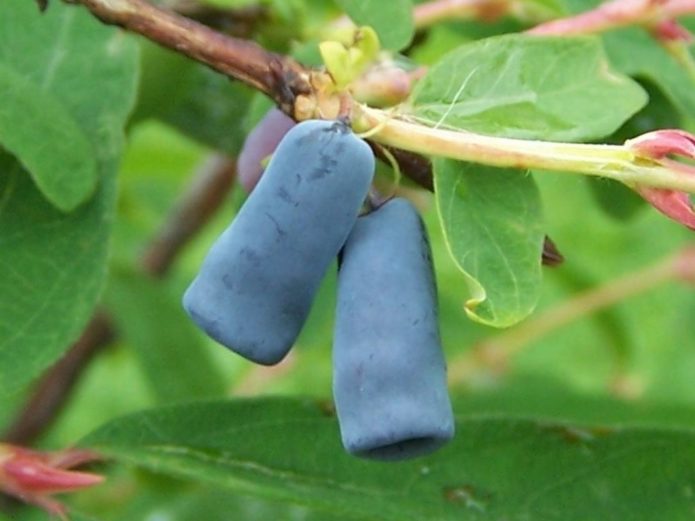
Gerd's honeysuckle, almost without the help of a gardener, forms a crown of the correct spherical shape
The berries are small (0.67 g), in the form of an almost regular oval. The skin is bluish-black with a slight bluish bloom, slightly tuberous, thin. The taste is sweet and sour, very good. It is estimated at 4.3 points. The aroma is weak.
The first fruiting is 3-4 years after planting. The harvest ripens in the last decade of June, in large quantities. Berries are rarely showered. They are located on long stalks, which is, in principle, atypical for honeysuckle.
Violet
Mid-season variety, bred in Ukraine. In the Russian State Register since 1995.
The bush is of medium height (1.3–1.5 m), the shoots are thick, pubescent. The crown is dense, spherical. This variety is suitable for creating hedges. Pastel pink flowers will give it additional decorativeness. Most honeysuckle varieties have a yellowish cream or lime color.
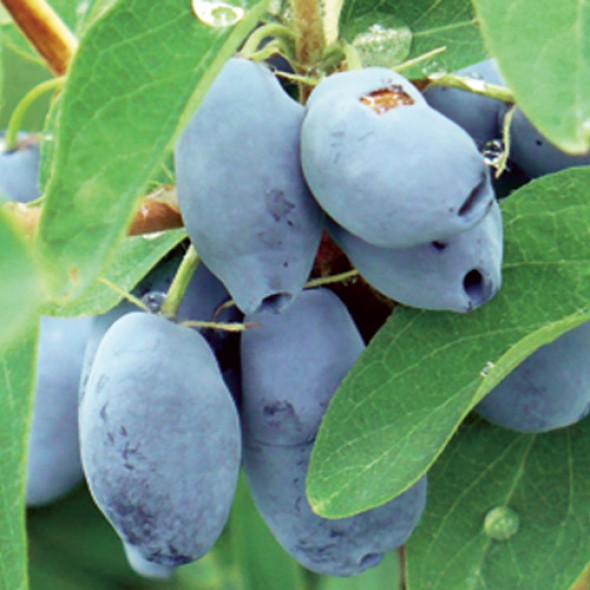
Honeysuckle Violet during flowering is easy to identify by the shade of petals atypical for the culture
The berries are rather large (1.1 g), broadly spindly, often slightly curved. The skin is bumpy, violet-blue, thick, with a bluish-gray bloom. The pulp is firm, slightly fibrous, sweet-sour taste, refreshing. Assessment of tasters - 4.3 points. Vitamin C content - 45 mg per 100 g, sugars - 9.1%.
In the homeland of the variety, the crop ripens at the end of May, in the Moscow region - in the third decade of June. The first fruits can be tasted 3-4 years after planting. Average yield - 1.3-1.8 kg per bush, in particularly successful years - 2.5 kg. The berries hardly crumble. The most suitable pollinators are Morena, Nymph, Blue Spindle.
Amphora
One of the most beloved varieties by Russian gardeners. In the State Register since 1998. The bush is medium-sized (1.5 m or slightly more), the crown is quite sparse, of the correct rounded shape. Shoots are straight, thin, extending from the roots at an angle. They are painted in an unusual deep crimson color, which is why the variety is popular among landscape designers.
The average weight of the berry is 1.1 g, the shape resembles a jug. At the top there is a slight thickening, like a roller. The skin is thick, bluish-blue, thick, gray coating. The pulp is dense, as if "gristly". The taste is balanced, sweet and sour, a bit like lingonberry. The tasters rated it 4.6 points. The variety belongs to the category of dessert. Vitamin C content - 58 mg per 100 g, sugars - 7.6%.
The first crop is harvested 3 years after planting. Fruiting is amicable, falls on the 20th of June. 1–2 kg of berries are removed from the bush. Suitable pollinators are Gzhelka, Violet, Bazhovskaya, Morena, Nymph, Altair.
The variety is characterized by the presence of resistance to secondary flowering. Some varieties of honeysuckle can form flower buds for the second time per season in the fall. Because of this, problems arise with the laying of flower buds for the next year, the harvest ripens very poorly.
Planting, preparation for it and tips for further crop care
Most gardeners in the Moscow region plant honeysuckle in the spring. The climate in the region is quite mild, and winter comes more or less in accordance with the calendar, but early frosts are also not out of the ordinary. Therefore, it is better to play it safe and let the plant adapt to new habitat conditions, form a developed root system and accumulate enough nutrients for wintering. The optimal time for the procedure is the last decade of April. You need to be in time before the leaf buds have blossomed.

There are a lot of varieties of honeysuckle suitable for growing in the Moscow region, it is advisable to purchase seedlings in nurseries located nearby.
When choosing a place for a honeysuckle bush, you need to find a large enough area for it. After all, you will need at least two more pollinators. The productive life of plants is rather long, 25–30 years, so it should be taken into account that over time, their dimensions increase significantly. The bushes are planted not in a row, but as if at the tops of a triangle. The most suitable substrate for culture is forest gray soil or loam.
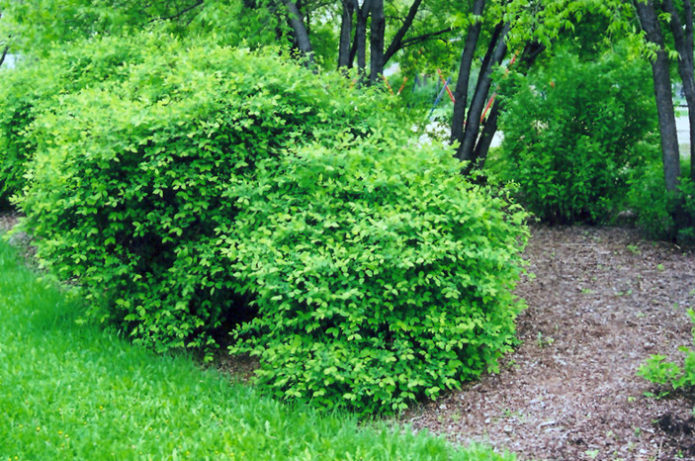
Honeysuckle loves sunlight, but it will also tolerate partial shade, and without much damage to yield
The best option is an open place well warmed by the sun, ideally a small hill. But the culture will tolerate partial shade, so the bush can be planted, for example, next to a fruit tree. Lowlands and areas where groundwater approaches the surface closer than a meter are excluded immediately. Waterlogged soil is practically the only thing that the culture categorically does not tolerate.
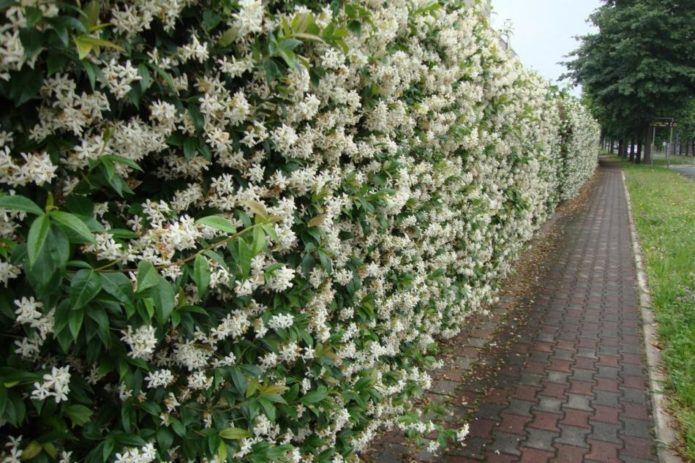
Many varieties of honeysuckle are successfully used by landscape designers, one of the most common solutions is a hedge
Also acidic and too "heavy" substrate does not suit her. The first can be leveled by introducing dolomite flour (150-200 g) into the planting pit, the second - by mixing coarse sand with the soil with which it will be filled (in a ratio of about 1: 1).
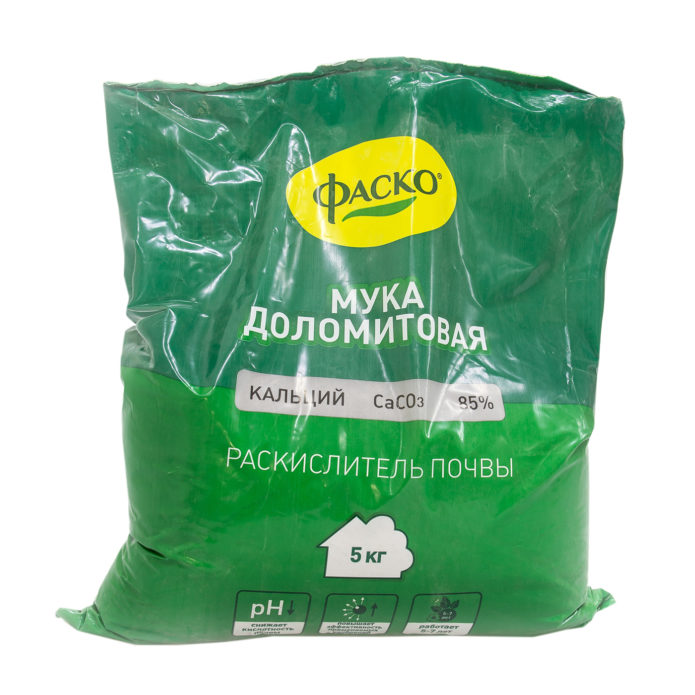
Dolomite flour is a natural soil deoxidizer that, if the recommended dosage is observed, does not have any side effects
The bush does not differ in its powerful root system, therefore, a hole about 0.5 m deep is sufficient for planting. At the bottom, a drainage layer is required (pebbles, expanded clay, brick chips, crushed stone). If the soil is quite nutritious in itself, you can do with natural fertilizers - humus (3-5 kg) and sifted wood ash (1.5-2 cups).

Honeysuckle does not tolerate moisture stagnation at the roots, therefore, a drainage layer is required at the bottom of the planting pit
Directly planting honeysuckle in the ground is practically no different from similar procedures for other berry bushes. The only caveat is that the root collar will need to be deepened by 7–8 cm.
Video: spring planting of honeysuckle
There is nothing difficult in caring for a culture in the Moscow region. Local winters are such that honeysuckle can easily endure the cold even without shelter. The culture rarely suffers from diseases and pests, almost never. In essence, the gardener will only need to keep the trunk circle clean and loosen it regularly, provide the plant with timely watering and feeding, and also regularly prune.
Watering is especially important for a newly planted honeysuckle bush. The soil is moistened daily during the first week, spending 10 liters of water per seedling. Mature shrubs need moisture most of all in spring, when the active growth of green mass begins, as well as during the ripening of the fruits. If the berries ripen against the background of a prolonged drought, they begin to noticeably bitter.
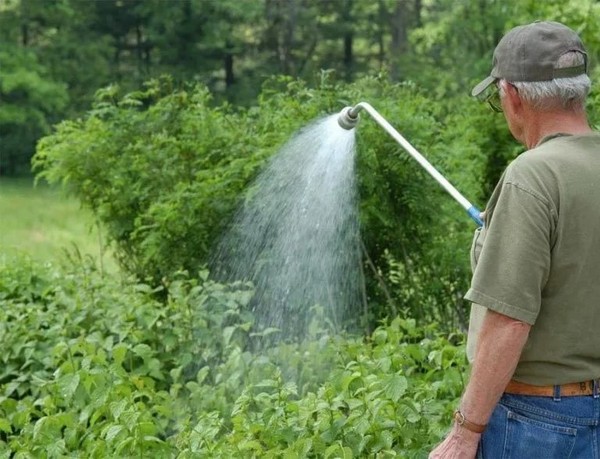
Even in a drought, honeysuckle does not need very frequent watering, their abundance is more important for it
It should be noted that an adult plant itself tolerates drought well. He needs not so much regular watering as abundant. As a rule, once every 12-15 days is enough. But the soil must be soaked to a depth of at least 40-50 cm. If there has been no precipitation for a long time, it takes at least 50 liters of water. Frequent but superficial watering is categorically not suitable for the bush.
Each time after watering, surface loosening of the soil is carried out in the near-trunk circle. The root system of honeysuckle is shallow, the roots are easily damaged. Then it is advisable to mulch this area. Such a procedure will save the gardener time on weeding and will allow to retain moisture in the soil, further increasing the interval between waterings. Some gardeners also mulch the soil in preparation for winter, bringing the thickness of its layer to 5-7 cm.
The first time the bush is fed for the third season of stay in a permanent place. In the process of loosening in the near-stem circle, any nitrogen-containing fertilizers are distributed - ammonium sulfate, urea, ammonium nitrate. Enough 10-12 g / m². Every second year, about a week after this procedure, organic matter is also introduced - humus or rotted compost (2-3 l / m²).
The period of active vegetation in honeysuckle is rather short, therefore, one, maximum two dressings are carried out per season. The second - after the end of fruiting, if the rate of growth and development of the bush does not suit you. The culture reacts very positively to natural organics. You can use an infusion of fresh cow dung, bird droppings, nettle leaves or dandelion leaves.
The procedure is carried out just before flowering.Some gardeners add a tablespoon of complex nitrogen-potassium-phosphorus fertilizer (Nitrofosk, Azofosk, Diammofosk) to 10 liters of the finished product. The experience of growing crops in the suburbs shows that timely fertilization has a positive effect on productivity.
The second time, honeysuckle is fed about three weeks after harvest. From natural fertilizers, wood ash is suitable in dry form or in the form of an infusion. The method is chosen depending on how rainy the summer is. You can also use any complex fertilizing for berry bushes. Nitrogen in the composition of the product should be at least half as much as phosphorus and potassium. An excess of this macronutrient in the soil closer to autumn prevents the plant from preparing normally for winter. Nutrients are used to form new shoots.
Video: honeysuckle care recommendations
The crown of many varieties of honeysuckle is quite thick, so pruning for it is a mandatory procedure. There are also varieties that require minimal gardener intervention in the crown formation process. In this case, it is limited to the removal of dried, no longer fruiting, branches that have broken under the weight of snow.
In the spring, only sanitary pruning is carried out, most of the work is postponed until autumn. By this time, the bush should completely lose its foliage. But it is no longer possible to shorten the shoots at negative temperatures.
For the first time, formative pruning is carried out 6–7 years after planting in the ground. You should not be especially zealous, most varieties of honeysuckle grown in the Moscow region do not differ in growth rate. Its main principles are as follows:
- The honeysuckle bush should have 4–5 shoots between two and five years of age. At the end of each season, the most powerful, developed and well-located branches are selected. Young growth is not touched.
- The crown should be more or less symmetrical. Its "skew" is especially evident when the place for the bush is not chosen very well, and one side receives noticeably more sunlight and heat.
- With a strong crown density, if pruning has not been carried out for several years, the so-called zero shoots that come directly from the soil are first removed. They also get rid of "tops" - upright powerful branches that do not bear fruit in principle.
- If in spring it seems that there are a lot of branches, first of all they cut off the weakly growing ones and directed deep into the bush so that it is evenly illuminated. But young shoots that formed only last season should not be touched. It is on them that most of the harvest ripens.
Rejuvenating pruning helps prolong the productive life of the honeysuckle bush. The first time it is carried out when they reach the age of 10. All shoots, with the exception of one- and two-year-old shoots, are cut, leaving only "hemp" 3-5 cm high. Then the formation of the bush begins anew.
Video: how to properly prune honeysuckle bushes
Honeysuckle is extremely rare in the Moscow region. From fungal diseases, powdery mildew can cause maximum harm to the bush. But in order to protect planting from it, as a rule, two preventive fungicide treatments are sufficient - at the beginning of the growing season, when leaf buds resemble green cones, and about 15–20 days after the end of fruiting.You can use both old time-tested and many generations of gardeners means (copper sulfate, Bordeaux liquid), and modern preparations of biological origin (Alirin-B, Fitosporin-M, Bayleton, Strobi).
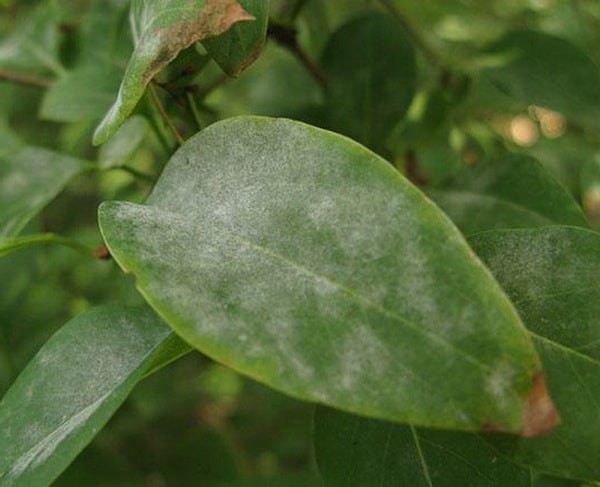
Powdery mildew seems to be a harmless bloom that can be easily wiped off the leaves, but in fact it is a very dangerous disease for most garden crops.
Of the pests, only aphids and caterpillars feeding on leaf tissues can cause any noticeable damage to the bushes. Moreover, the latter, perhaps, only in cases of their massive invasion of the site, which happens quite rarely.
All flying insects are effectively scared away by strong odors. Therefore, next to honeysuckle, you can plant any spicy herbs, as well as marigolds, nasturtiums, lavender, sage. Ordinary sticky tape for catching flies and homemade traps do a good job. Of the chemicals used are Entobacterin, Lepidocid, Bitoxibacillin.
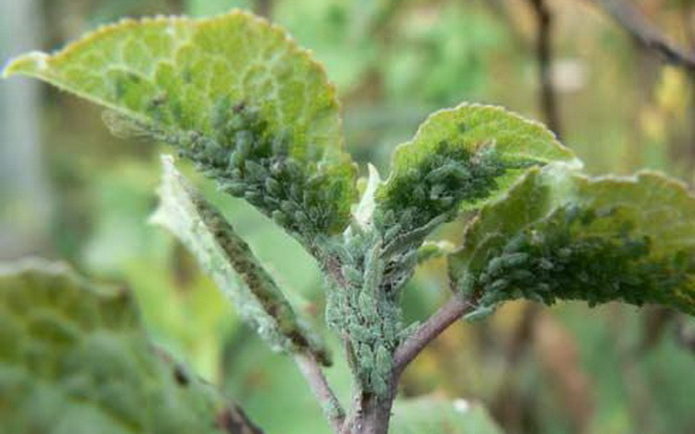
Aphids live in close symbiosis with ants, so you will have to fight with those and other insects at the same time
Caterpillars and aphids are destroyed using any general action insecticides - Aktara, Aktellik, Decis, Inta-Vir. But if their appearance is noticed on time, folk remedies are enough. These are infusions of mustard powder, chili peppers, onion and garlic arrows, pine needles, vinegar essence diluted with water. In the process of loosening, the soil in the near-trunk circle can be powdered with colloidal sulfur, tobacco crumbs.
Honeysuckle owes its popularity not only to the taste and beneficial properties of berries. Gardeners highly appreciate the shrub for its unpretentiousness, frost resistance and consistently high yield, even if the weather in spring and summer is not too lucky. There is nothing difficult in growing it in the suburbs, the plant is more than satisfied with the local climate. From a wide range of existing varieties, it is quite possible to choose several of the most suitable ones, having previously familiarized yourself with their advantages and disadvantages.
